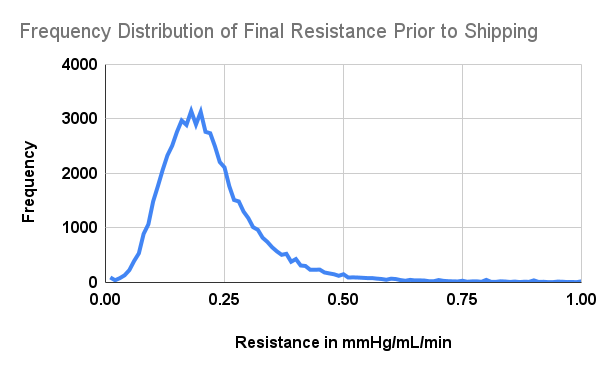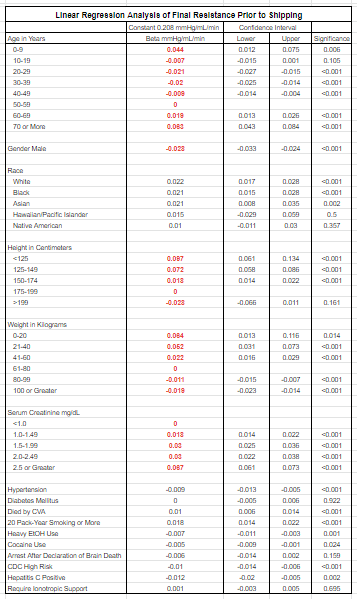Cold Pulsatile Perfusion Resistance of Deceased Donor Kidneys Mainly Dependent on Renal Mass, Donor Age and Donor AKI, Other Donor Factors Have Minimal Impact
Kidney Transplant, Sacred Heart Hospital, Pensacola, FL
Meeting: 2022 American Transplant Congress
Abstract number: 909
Keywords: Cadaveric organs, Kidney, Machine preservation, Prediction models
Topic: Clinical Science » Organ Inclusive » 69 - Non-Organ Specific:Organ Preservation/Ischemia Reperfusion Injury
Session Information
Session Name: Non-Organ Specific: Organ Preservation/Ischemia Reperfusion Injury
Session Type: Poster Abstract
Date: Saturday, June 4, 2022
Session Time: 5:30pm-7:00pm
 Presentation Time: 5:30pm-7:00pm
Presentation Time: 5:30pm-7:00pm
Location: Hynes Halls C & D
*Purpose: To determine the factors influencing resistance to flow during cold pulsatile perfusion preservation (CPPP) of deceased donor kidneys.
*Methods: All donor kidneys procured for possible kidney transplant, whether transplanted or discarded, that were placed on a CPPP machine and had final resistance coded were identified in the SRTR database from 1/1/2010 until 9/2/2020. Donor parameters were determined from the database including demographic, size, kidney biopsy, substance use, and donor management data. Linear regression was carried out to determine which factors influenced the final resistance.
*Results: 61,563 deceased donor kidneys were identified that received cold pulsatile perfusion preservation and had final resistance measurements. 1421 pumped kidneys were missing final resistance values and were excluded from the analysis. The frequency distribution of final resistance prior to shipping did have a bell shaped distribution with a long tail of outliers.
The median, mean and standard deviation were 0.20, 0.23 and 0.144 mmHg/mL/min respectively. Univariant analysis showed donor age, height, weight, gender, percent glomerulosclerosis in those biopsied and serum creatinine of the donor had the greatest impact on resistance. Donor age had a U-shaped effect on resistance with very young donors and older adult donors having higher resistance. Linear regression analysis showed that age and gender influence was partly due to donor size. Other donor characteristics such as hypertension, diabetes mellitus, death from CVA, smoking, drug and alcohol use, warm ischemia time, donation after cardiac death and use of vasopressors had only minor impacts on resistance.
*Conclusions: The most important factors in determining final resistance prior to shipping during CPPP were mainly factors that influenced kidney mass such as donor size, age, gender, and percent glomerulosclerosis on biopsy. Acute kidney injury also impacted resistance. The factors identified did not explain the high resistance outliers suggesting other unidentified factors may be important. Surprisingly, factors like hypertension and ionotropic support of the donor had only minor impacts on resistance measures.
To cite this abstract in AMA style:
Keith D, Lessmann E. Cold Pulsatile Perfusion Resistance of Deceased Donor Kidneys Mainly Dependent on Renal Mass, Donor Age and Donor AKI, Other Donor Factors Have Minimal Impact [abstract]. Am J Transplant. 2022; 22 (suppl 3). https://atcmeetingabstracts.com/abstract/cold-pulsatile-perfusion-resistance-of-deceased-donor-kidneys-mainly-dependent-on-renal-mass-donor-age-and-donor-aki-other-donor-factors-have-minimal-impact/. Accessed December 17, 2025.« Back to 2022 American Transplant Congress


